Agricultural Research and Development: How to Grow Enough Food for Everyone With the Least Carbon Emissions
New Report "Growing Green" analyzes the environmental benefits of public research and development
-
-
Share
-
Share via Twitter -
Share via Facebook -
Share via Email
-
Executive Summary
The 20th century was a time of massive changes in US agriculture. From farmers scraping a living out of the land to running multi-thousand-acre operations. From cowboys and cattle drives to feedlots. From horse-drawn plows to GPS-guided tractors. Altogether, US agriculture became larger, more export-oriented, and much more efficient.
These transformations produced abundant food, allowed huge swaths of the population to escape the drudgery of farm labor, and enabled the economic growth that has undergirded modern American life. Not everyone benefited equally: many small- and mid-scale farmers had little choice but to sell their operations. Yet the benefits of agricultural modernization—not only economic but also environmental—have been unprecedented. Growth in agricultural productivity has reduced food prices; cut the carbon footprint of milk, chicken, beef, and many other products; reduced land use; and led to more efficient use of many resources.
This modern miracle of agricultural abundance owes much to over a century of public funding for agricultural research and development (R&D).
But after years of steady growth, public agricultural R&D funding in the United States is waning. The United States no longer leads the world in public agricultural R&D funding. Falling R&D investment threatens to forfeit the advantages and benefits of agricultural advancements in the face of increasing global competition and new threats, such as climate change, geopolitical strife, and the COVID-19 pandemic. Increasing federal R&D funding can maintain, if not increase, the competitiveness of US farmers while representing one of the greatest opportunities to mitigate greenhouse gas emissions from agriculture, reduce land use, and keep food prices low around the world.
This report begins with a brief history of US agricultural transformations before painting a broad picture of US public agricultural research agencies and capacity. We find that public agricultural R&D investment has declined by one-third, in real dollars, since 2000 and has fallen as a portion of total US R&D investment. While private agricultural R&D has increased, it tends to focus more on commercial opportunities and less on long-term, productivity-enhancing research.
Subsequently, we describe how public agricultural R&D has had significant climate and environmental benefits. As farm yields increased over the 20th century, less land was required to produce the same quantity of food, fiber, and other agricultural products. For example, if US corn yields had remained stagnant from 1961 to 2020, corn farmers would have needed additional land the size of France to produce the same total amount of corn in 2020. Although yield gains in that period were partially due to greater use of fertilizer, fuel, and other energy-intensive farm inputs, the carbon footprint of key agricultural goods declined.
R&D-driven productivity growth can continue to generate large environmental benefits in the future. A new analysis commissioned by the Breakthrough Institute projects that doubling public US agricultural R&D spending would reduce global emissions by 213 million metric tons of carbon dioxide-equivalent per year, corresponding to over one-third of current US agricultural emissions. This mitigation would cost about $12 per ton of abated emissions, less than many other climate policies, while generating other benefits such as increased domestic agricultural production and lower prices.
Given such benefits, Congress should at least double funding for agricultural R&D, bolstering well-established agencies such as the Agricultural Research Service and National Institute of Food and Agriculture, as well as expanding newer efforts such as the Foundation for Food & Agriculture Research and the Agriculture Advanced Research and Development Authority. Doing so would entail at least an additional $3.4 billion in annual funding. This additional support should be directed, in particular, toward areas that increase productivity and reduce agriculture’s carbon footprint while addressing other environmental concerns. These R&D priorities include livestock breeding; genetic engineering; developing crops with deeper roots that sequester more carbon; improving meat and dairy alternatives; and creating low-carbon fertilizers that generate less runoff.
Download the report PDF >>>
Introduction
History
Technology has come to define US agricultural production. Tractors, sensors, GPS, energy-intensive fertilizers and other inputs, massive combines, and genetically modified seeds are almost a given on most American farms. Long gone are the days of nuclear families tending small plots. We are, instead, in the age of factories in the fieldDeborah Fitzgerald, Every Farm a Factory: The Industrial Ideal in American Agriculture
(New Haven, CT: Yale University Press, 2001).—the long-run project of America’s agricultural and research institutions. The urge toward scale, rationalization, and industrialization of agriculture has been prominent among American agriculturalists for over a century, producing new political and ecological outcomes and an unprecedented abundance of foods.
US agriculture, even before the 20th century, attempted to create rational and technological solutions to the problems it faced. Nineteenth-century agricultural producers sought out new technologies, inputs, and practices to overcome nutrient deficiencies and soil depletion and meet the needs of a growing population.Ariel Ron, Grassroots Leviathan: Northern Agricultural Reform in the Slaveholding Republic
(Baltimore: Johns Hopkins University Press, 2020).Emily Pawley, The Nature of the Future: Agriculture, Science, and Capitalism in the Antebellum North (Chicago: University of Chicago Press, 2020). After the emancipation of enslaved persons in the United States, labor costs forced producers to turn to technological solutions to problems once solved through cruel forced labor, at least in former slaveholding states.
The founding of the US Department of Agriculture (USDA) in 1862—termed the People’s Department by its founding executive, President Abraham Lincoln—institutionalized the push to rationalize agricultural production under a federal agency. Roughly since then, the US federal government has been an active participant in developing the key knowledge, technologies, and practices that have undergirded agricultural productivity growth both in the United States and around the world.
Alongside the USDA, the United States’ land-grant and public universities have been key institutions for the development and improvement of US agriculture. Created by the Morrill Act of 1862, and subsequently expanded by multiple legislative acts, the United States’ land-grant and public universities were intended to drive economic growth through research and teaching in “agriculture and the mechanic arts.”
For agriculture, the land-grant universities (LGUs) have also played an extremely important role as sites of extension: where formal academic research is translated and dispersed to local and regional agricultural producers. Extension programs have also served to extend farmer- and producer-led innovations more widely. Farmers are, after all, famous tinkerers and innovators in their own right.
Today, land-grant and public institutions include major private universities such as Cornell University in the state of New York; large state schools such as the University of California, Berkeley; historically Black colleges and universities, such as the University of the District of Columbia; and tribal colleges, such as the University of North Carolina at Pembroke.
Over the course of the 20th century, US agriculture embraced technological progress in all forms. This led to many socioeconomic, environmental, and food price outcomes.
In 1900, 41 percent of the US workforce was employed in agriculture.Carolyn Dimitri, Anne Effland, and Neilson Conklin, The 20th Century Transformation of US Agriculture and Farm Policy, USDA Economic Research Service, June 2005, 2, https://doi.org/10.1017/S0022050720000649. Farms were small, diversified, and incredibly labor-intensive. Alongside the large number of human workers, the turn-of-the-century American farm economy also utilized 21.6 million work animals.Dimitri et al., 20th Century Transformation, 6. By 1945, US agriculture as a share of the total workforce fell by more than half, to only 16 percent of the total labor force; and by the end of the century, agriculture employed less than 2 percent of US workers.Dimitri et al., 20th Century Transformation, 2.
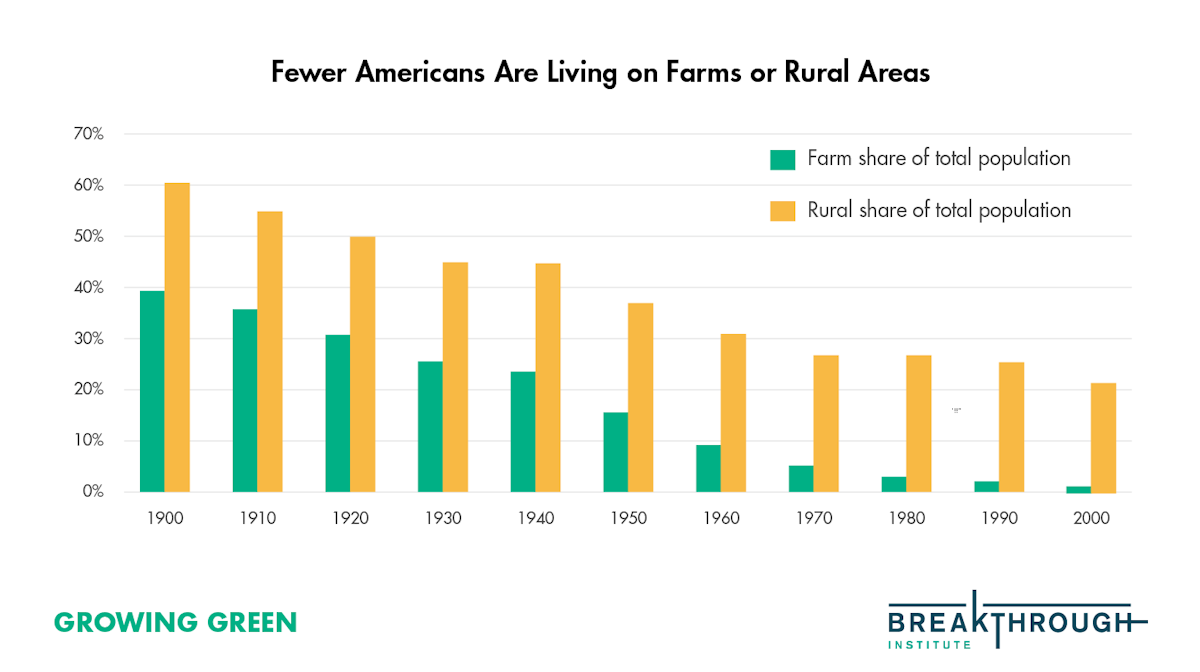
As the percentage of the total US workforce employed in agriculture declined, so too did the number of farms.Dimitri et al., 20th Century Transformation, 4.James M. Macdonald and Robert A. Hoppe, Examining Consolidation in US Agriculture (Washington, DC: USDA Economic Research Service, 2018). The plethora of small, diversified farms was replaced by fewer but significantly larger and more specialized farms.
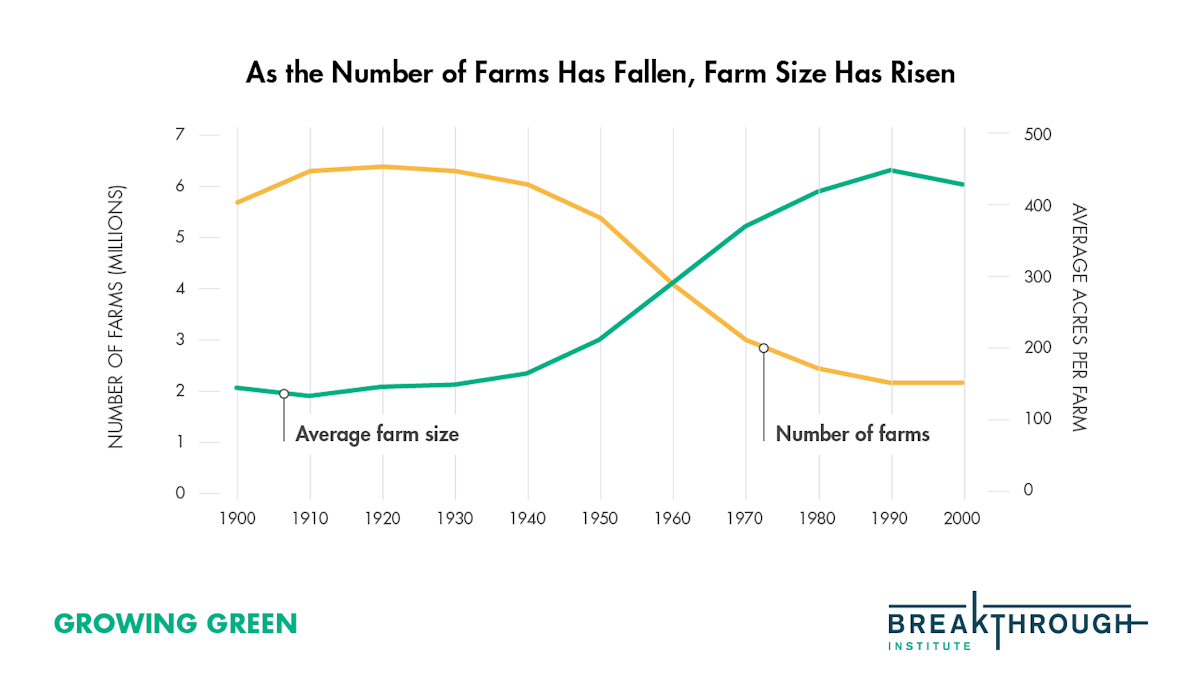
Over the same period, farm mechanization and high-quality chemical inputs such as fertilizers and pesticides drastically reduced the need for labor, both human and animal. In 1960, the number of working animals had decreased to only three million, or about 14 percent of the 1900 total, replaced by 4.7 million tractors.Dimitri et al., 20th Century Transformation, 6. Mechanization, chemical innovations, and other technological advances created economies of scale for agricultural production. Larger, more capitalized farms could produce much more per acre while incurring similar or sometimes lower expenses.Catherine Morrison Paul et al., “Scale Economies and Efficiency in US Agriculture: Are Traditional Farms History?,” Journal of Productivity Analysis 22 (2004): 185-205, https://link.springer.com/article/10.1007/s11123-004-7573-1.
Agricultural Productivity Growth and R&D Spending Have Slowed
The 20th century witnessed massive productivity growth in American farming. Especially in the decades following World War II, US agricultural productivity surged, often growing at rates faster than non-farm productivity.
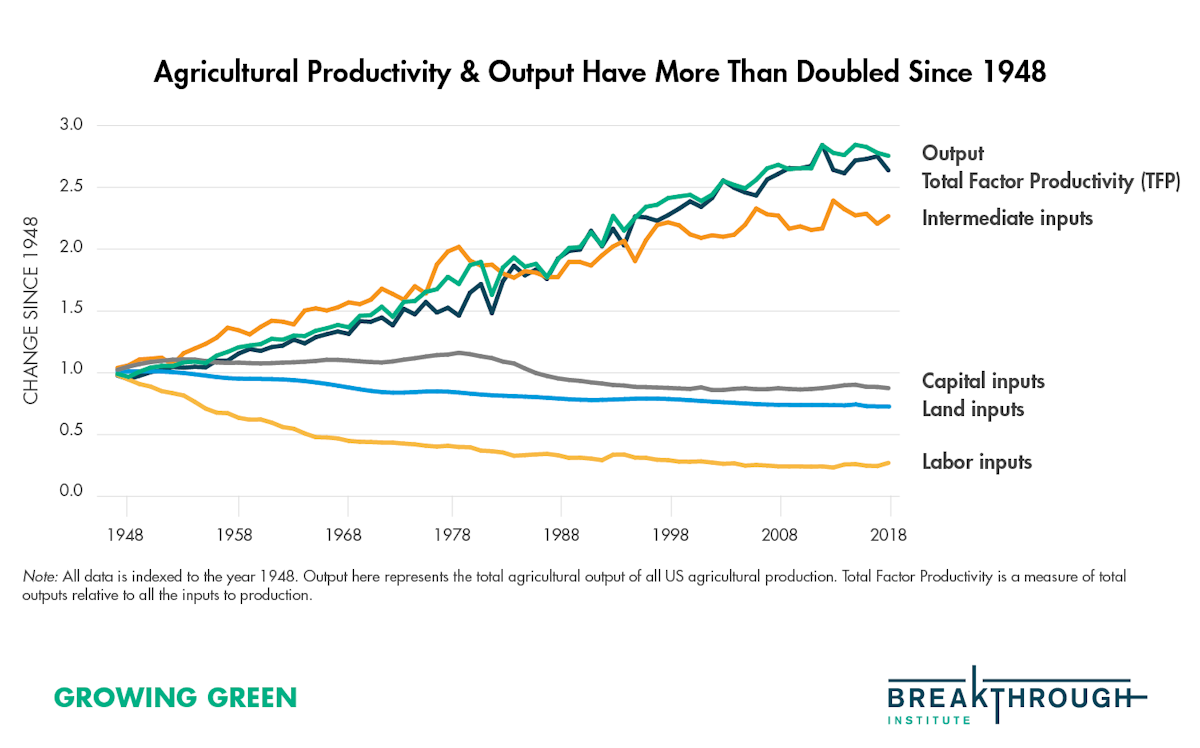
While rapid productivity growth in US agriculture cannot be completely explained by long-run public support for agricultural research and development (R&D), it played a significant role. The creation of the USDA and the LGUs provided crucial infrastructure, technological dispersion, and innovation networks that fostered broad-scale technological progress in farming.
Over the past four decades, agricultural productivity growth has slowed significantly.Philip Pardey and Julian Alston, “Unpacking the Agricultural Black Box: The Rise and Fall of American Farm Productivity Growth,” Journal of Economic History 81, no. 1 (2021), https://doi.org/10.3886/E130481V1. Unfortunately, so too has US public sector spending on agricultural R&D.Matthew Clancy, Keith Fuglie, and Paul Heisey, “U.S. Agricultural R&D in an Era of Falling Public Funding,” USDA Economic Research Service, November 2016, https://www.ers.usda.gov/amber-waves/2016/november/us-agricultural-r-d-in-an-era-of-falling-public-funding/.
In 1960, the United States was far and away the world leader in public agricultural R&D spending—accounting for 20 percent of global public funding in that area.Philip G. Pardey and Julian M. Alston, “The Drivers of US Agricultural Productivity Growth,” Federal Reserve Bank of Kansas City, 11-12, accessed July 2, 2022, https://www.kansascityfed.org/documents/7107/the-drivers-of-us-agricultural-productivity-growth.pdf. Since then, the United States has fallen behind. In 2015, the United States accounted for only 8.9 percent of global public R&D spending in agriculture, taking second place to China, with 14.5 percent.Pardey and Alston, “Drivers of US Agricultural Productivity Growth,” 12. This is due both to long-run slowing of the growth rate in US public agricultural R&D spending and higher growth rates in other countries, like China, which have increased public investment for strategic, food security, and economic reasons.
From its peak in 2002, US public spending on agricultural R&D, adjusted for inflation, fell by about a third to $5.16 billion in 2019, similar to the level of spending in the 1970s.Kelly P. Nelson and Keith Fuglie, “Investment in US Public Agricultural Research and Development Has Fallen by a Third Over Past Two Decades, Lags Major Trade Competitors,” USDA Economic Research Service, June 6, 2022, https://www.ers.usda.gov/amber-waves/2022/june/investment-in-u-s-public-agricultural-research-and-development-has-fallen-by-a-third-over-past-two-decades-lags-major-trade-competitors/. Drops in state fund-ing for agricultural R&D made up about half of the inflation-adjusted decline. USDA and other non-federal R&D investment has also fallen precipitously, by 22 percent and 56 percent respectively, since their peaks in the early 2000s.Data shared with authors by Keith Fuglie, USDA Economic Research Service. Still, in 2019, USDA intramural and extramural R&D invest-ment was responsible for 64 percent of total public agricultural R&D, compared to 45 percent in 2002, signaling the relative slowdown of investment from state and other federal sources.Data shared with authors by Keith Fuglie, USDA Economic Research Service.
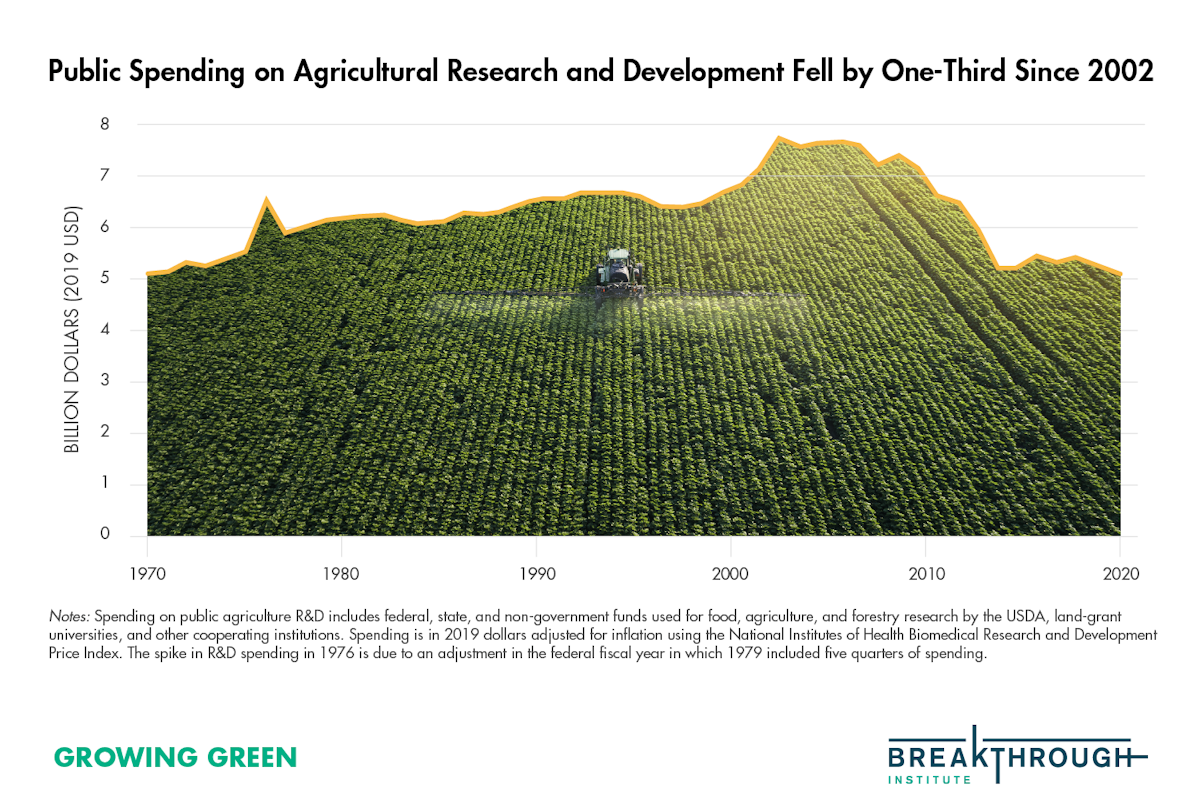
Private R&D spending on food and agriculture has vastly outpaced public R&D, despite the two sectors’ having different motivations and often different research priorities. Since 1950, the public share of US agricultural R&D spending went from 65.1 percent of total agricultural R&D spending in the country to 31.3 percent in 2017.Pardey and Alston, “Drivers of US Agricultural Productivity Growth,” 12.
Even in combination with private R&D spending, agricultural R&D as a share of total public and private US R&D spending declined by about a third from 1950 to 2015.Pardey and Alston, “Drivers of US Agricultural Productivity Growth,” 12.
Research Programs Today
The USDA remains the primary administrator of public agricultural R&D funding. Total funds allocated for US public agricultural R&D, including by the USDA, other federal agencies, state governments, and non-government funders, was $5.04 billion in 2019, the most recent year
for which amounts are available.Graphic on funders and performers of US public agricultural research in 2019, in Nelson and Fuglie, “Investment in US Public Agricultural Research.” Of that total, the USDA administered $2.77 billion through the National Institute of Food and Agriculture (NIFA), the Agricultural Research Service (ARS), and smaller agricultural R&D agencies and programs.Nelson and Fuglie, “Investment in US Public Agricultural Research.”
Among other activities, NIFA funds outside researchers at universities, private firms, and other institutions through several programs. Chief among those is the Agriculture and Food Research Initiative (AFRI), which provides grants across priority areas such as plant health, animal production, bioenergy, and natural resources. NIFA also provides “capacity grants” on a formula basis to state and territorial institutions such as state agricultural experiment stations of land-grant universities established by the Morrill Act of 1862 and colleges of agriculture at historically Black colleges and universities established through the Morrill Act of 1890.Nelson and Fuglie, “Investment in US Public Agricultural Research.”
Two other NIFA programs are the Specialty Crop Research Initiative (SCRI) and the Organic Agriculture Research and Extension Initiative (OREI). NIFA also provides funding for the Sustainable Agriculture Research and Education program and other smaller research initiatives.
The ARS, the USDA’s chief scientific in-house research agency, operates more than 90 research locations that cover 660 research projects.“About ARS,” USDA Agricultural Research Service, accessed May 18, 2022, https://www.ars.usda.gov/about... Its flagship research center, in Beltsville, Maryland, is one of the largest agricultural research facilities in the world.“Research,” USDA Agricultural Research Service, accessed July 5, 2022, https://www.ars.usda.gov/northeast-area/docs/systematics-research/research/. The ARS has historically been a major contributor to agricultural innovation and R&D more broadly. For example, the technology to manufacture penicillin at scale was discovered at an ARS laboratory in Peoria, Illinois, in the early 1940s.“Penicillin: Opening of an Era,” USDA Agricultural Research Service, accessed June 30, 2022, https://www.ars.usda.gov/midwe...,-Mycotoxin%20 Prevention%20and&text=Penicillin%20was%20discovered%20in%201928,ability%20to%20kill%20 infectious%20bacteria.
Beyond NIFA and the ARS, other parts of the USDA are the Economic Research Service, which conducts economic research on trends and issues related to agriculture, and the National Agricultural Statistics Service, which collects and publishes agricultural statistics and other information on a regular basis. In addition, the 2018 Farm Bill authorized the USDA to establish a pilot Agriculture Advanced Research and Development Authority through the USDA Office of the Chief Scientist, but it has yet to be fully funded.
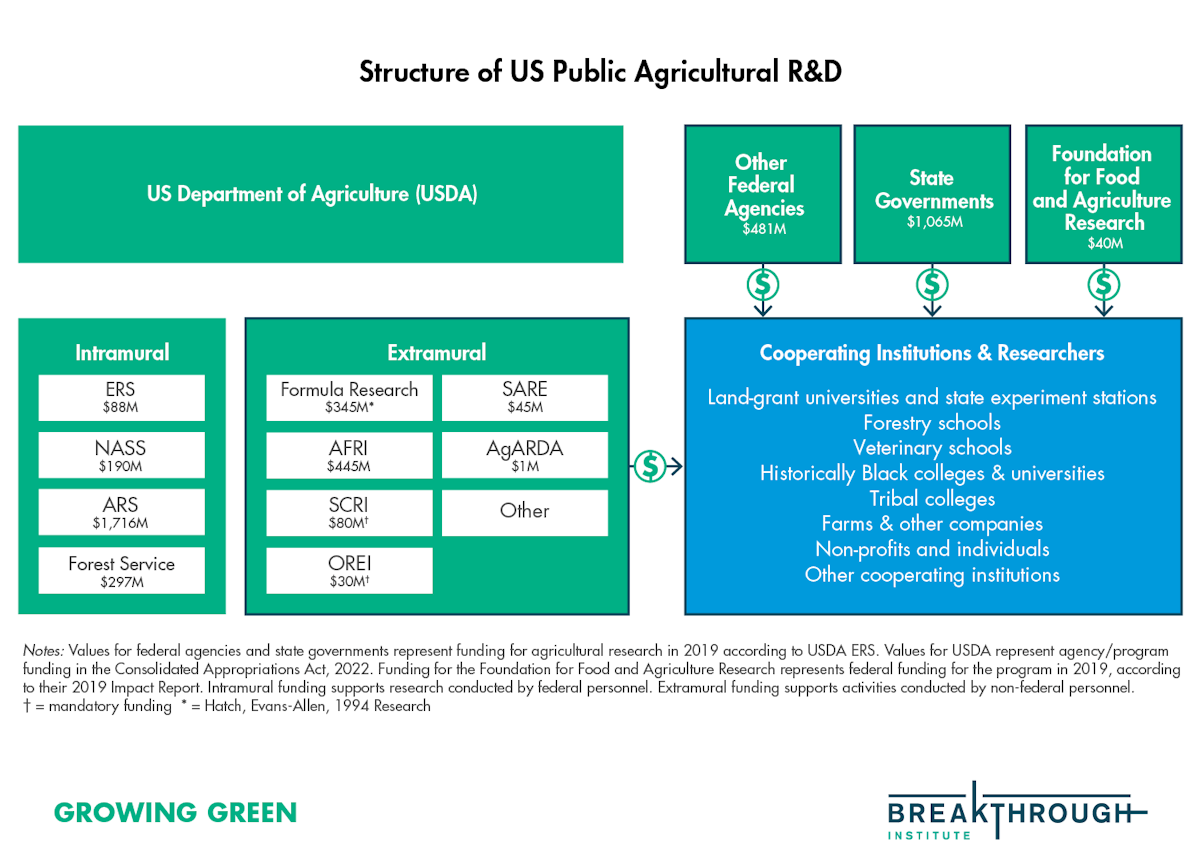
Other federal agencies fund agricultural R&D as well. These agencies include the National Science Foundation, which funds diverse research across agricultural and food topics, the National Institutes of Health, the National Aeronautics and Space Administration, the Department of Defense, and the Department of Energy. In 2019, federal agencies besides the USDA funded about 9.5 percent, $481 million, of public agricultural R&D.Graphic on funders and performers of US public agricultural research in 2019, in Nelson and Fuglie, “Investment in US Public Agricultural Research.” The Department of Energy’s Advanced Research Projects Agency-Energy, for example, funds a minor amount of research into agricultural soil carbon sequestration, plant breeding, and other agricultural topics related to bioenergy and climate change mitigation.“ROOTS: Rhizosphere Observations Optimizing Terrestrial Sequestration,” ARPA-E, accessed June 7, 2022, https://arpa-e.energy.gov/technologies/programs/roots.“SMARTFARM: Systems for Monitoring and Analytics for Renewable Transportation Fuels from Agricultural Resources and Management,” ARPA-E, accessed June 7, 2022, https://arpa-e.energy.gov/technologies/programs/smartfarm.
State governments also play a role in funding public agricultural R&D through their own departments of agriculture, state agricultural schools, and other public universities. In 2019, state governments funded about 21 percent—$1.06 billion—of public agricultural R&D.Graphic on funders and performers of US public agricultural research in 2019, in Nelson and Fuglie, “Investment in US Public Agricultural Research.”
Other non-federal and non-state funding, such as from public-private partnerships and other cooperating institutions like universities that do not fall into the land-grant university categorization, is another source of agricultural R&D support. In the 2014 Farm Bill, the federal government established the Foundation for Food & Agriculture Research, a nonprofit organization partially funded by Congress, with the goal of creating connections among researchers, funders, and stakeholders to create public-private partnerships driving forward food and agriculture research.“About FFAR,” Foundation for Food & Agriculture Research, accessed July 5, 2022, https://foundationfar.org/about/. In 2019, non-state and non-federal public R&D investments totaled $741 million, or about 15 percent of total public agricultural R&D.Graphic on funders and performers of US public agricultural research in 2019, in Nelson and Fuglie, “Investment in US Public Agricultural Research.”
R&D Grows More Than Just the Farm Economy
Public agricultural R&D funding, by improving productivity, has broad economic benefits—aiding consumers, spurring development of new companies and industries, and making US agriculture more globally competitive. And yet, the immediate economic benefits have not been evenly dispersed among farmers. Productivity growth for highly capitalized and larger producers meant the crowding out of smaller, less-capitalized producers. Overall, this process has driven national economic growth by freeing up labor for non-agricultural sectors, but with collateral damage for those producers pushed out of farming.Kathryn Marie Dudley, Debt and Dispossession: Farm Loss in America’s Heartland (Chicago: University of Chicago Press, 2000).
Still, a 2018 study found that every dollar spent on US agricultural R&D has, on average, generated $20 in benefits for consumers and the broader economy.Uris Lantz C. Baldos et al., “R&D Spending, Knowledge Capital, and Agricultural Productivity Growth: A Bayesian Approach,” American Journal of Agricultural Economics 101, no. 1 (2018): 291–310, https://doi.org/10.1093/ajae/aay039. To be sure, public agricultural R&D does not generate immediate returns; economists point to a long lag time between funding R&D and the innovation and economic benefits associated with that investment.Sun Ling Wang et al., “Public R&D, Private R&D, and US Agricultural Productivity Growth: Dynamic and Long-Run Relationships,” American Journal of Agricultural Economics 95, no. 5 (2013): 1287-93.Keith O. Fuglie and Paul W. Heisey, Economic Returns to Public Agricultural Research, USDA Economic Research Service, Economic Brief Number 10, September 2007, 3, https://www.ers.usda.gov/webdocs/publications/42826/11496_eb10_1_.pdf?v=7433.8. Nevertheless, a 2007 analysis of 27 studies found that public agricultural R&D as a whole generated returns ranging from 20 to 60 percent compared to the annual 3-4 percent rate of return for typical government securities at the time.Cited in Fuglie and Heisey, Economic Returns to Public Agricultural Research.
Private R&D, despite high social rates of return, has significantly lower private rates of return: the amount that a company or institution can make from patent licensing, selling technologies, or pursuing other commercialization strategies.Personal communication with Keith Fuglie, USDA Economic Research Service. Median and mean estimates for social returns to private R&D in the United States were reported in 2008 as being 45 percent, meaning that private research is about as beneficial to the broader economy as public R&D investment.Keith Fuglie and Paul Heisey, “Agricultural Research Sustains Productivity Growth and Earns High Returns,” USDA Economic Research Service, February 1, 2008, https://www.ers.usda.gov/amber-waves/2008/february/agricultural-research-sustains-productivity-growth-and-earns-high-returns.But the fact that private rates of return are low has resulted in the underfunding of private R&D.
One of R&D’s chief economic benefits is its role in reducing food prices. Despite periods of high food inflation, commodity food prices have decreased dramatically over the past century as growth in agricultural productivity and food supply has outpaced growth in population and food demand. For example, from 1950 to 2008, each year the price of rice declined in real terms by 1.9 percent, wheat by 1.8 percent, soybeans by 1.6 percent, and corn by 2.3 percent.Julian M. Alston, Jason M. Beddow, and Philip G. Pardey, “Mendel Versus Malthus: Research, Productivity, and Food Prices in the Long Run,” University of Minnesota Department of Applied Economics, Staff Paper Series, 2009, 5.
The decline in public agricultural R&D funding in the last three decades is therefore doubly concerning. It has coincided with a slowdown both in agricultural productivity growth and in the decline of food prices. Low rates of R&D funding and productivity growth in the future could contribute to increases in global food prices if production does not keep pace with increasing global demand.
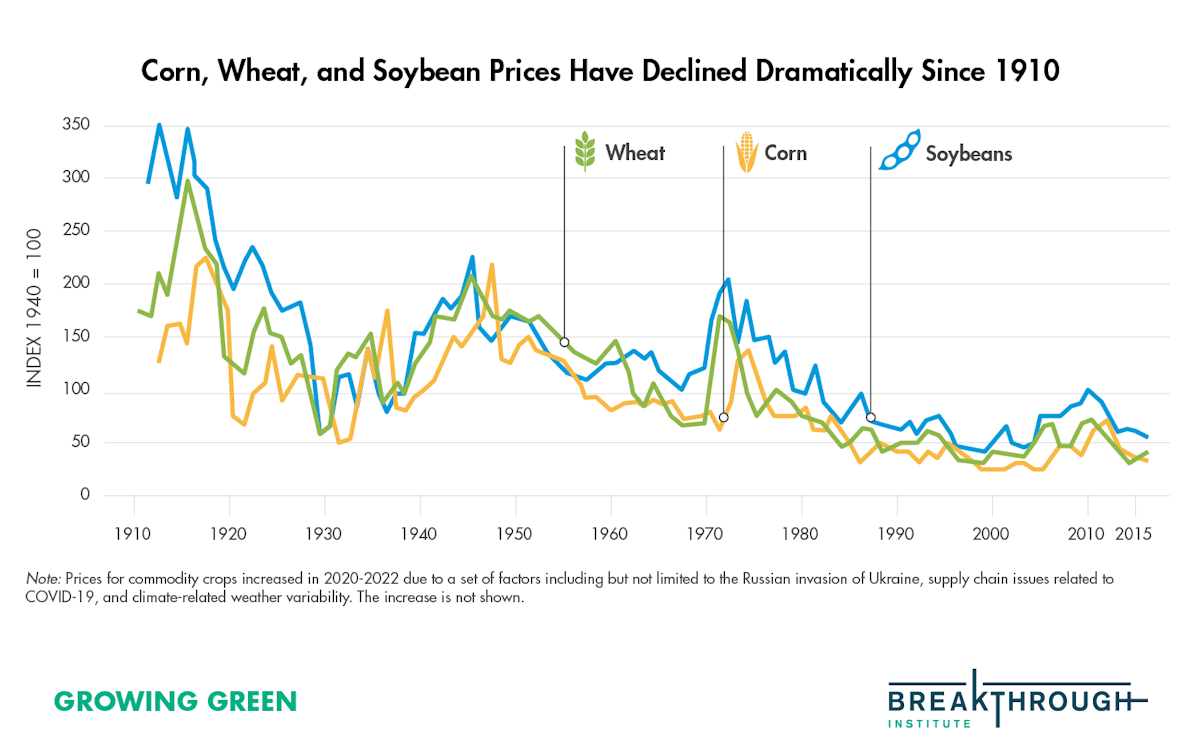
Environmental Benefits of US Agricultural R&D
The mechanization, rationalization, and consolidation of US agriculture are often seen as a major threat to local ecosystems, rural economies, and the global climate. The mainstream environmentalist position on large-scale, technological farming remains sharply critical.
This is not without reason. The US food system generates substantial water and air pollution; technological progress has made millions of farmers redundant and posed massive socioeconomic challenges to rural economies; agriculture remains a large greenhouse gas emitter with roughly 11 percent of all US greenhouse gas emissions stemming from agriculture in 2020;“Inventory of US Greenhouse Gas Emissions and Sinks,” Environmental Protection Agency, updated April 14, 2022, https://www.epa.gov/ghgemissions/inventory-us-greenhouse-gas-emissions-and-sinks. and, counter to environmentalist aesthetics, agriculture has flattened out and made uniform vast swaths of American land.
However, contemporary criticism of American agriculture often fails to take into account the counterfactual.
Productivity Growth Has Limited Land Use and Greenhouse Gas Emissions
The 20th century was a century of agricultural productivity growth. US agricultural yields and overall productivity measures increased multifold. Total factor productivity (TFP), a measure of the value of agricultural production relative to all inputs used in agriculture, increased by 4.6-fold between 1910 and 2007.Pardey and Alston, “Drivers of US Agricultural Productivity Growth,” 5.
The 20th century’s increase in US agricultural TFP has been a boon for the climate. Despite the agricultural narrative of mainstream environmentalism and other alternative food critics, US agricultural productivity growth has reduced land use and thereby greenhouse gas emissions, habitat loss, and other environmental impacts associated with land-use change compared to a scenario in which the same level of food demand was met with less productive agriculture. For example, if corn yields had remained the same since 1960, the United States would need approximately 227 million acres to produce the same amount produced on about 82 million acres in 2020.Data retrieved from FAOStat, accessed July 6, 2022, https://www.fao.org/faostat/en/#home. In other words, without growth in corn yields, additional cropland the size of France would be needed.Not including French overseas departments or territories.
In fact, productivity growth contributed to a decline in total agricultural land use since the second half of the 20th century. Between 1949 and 2012, the total acreage of US cropland for crops and pasture, grassland used for pasture, and forest land used for pasture declined by about a fifth, all while agricultural output increased by over twofold.Daniel P. Bigelow and Allison Borchers, Major Uses of Land in the United States, 2012, USDA Economic Research Service, August 2017, 5, https://www.ers.usda.gov/webdocs/publications/84880/eib-178. pdf?v=0.Sun Ling Wang et al., Agricultural Productivity Growth in the United States: Measurement, Trends, and Drivers, USDA Economic Research Service, July 2015, iii and 5, https://www.ers.usda.gov/webdocs/publications/45387/53417_err189.pdf?v=1703.2.
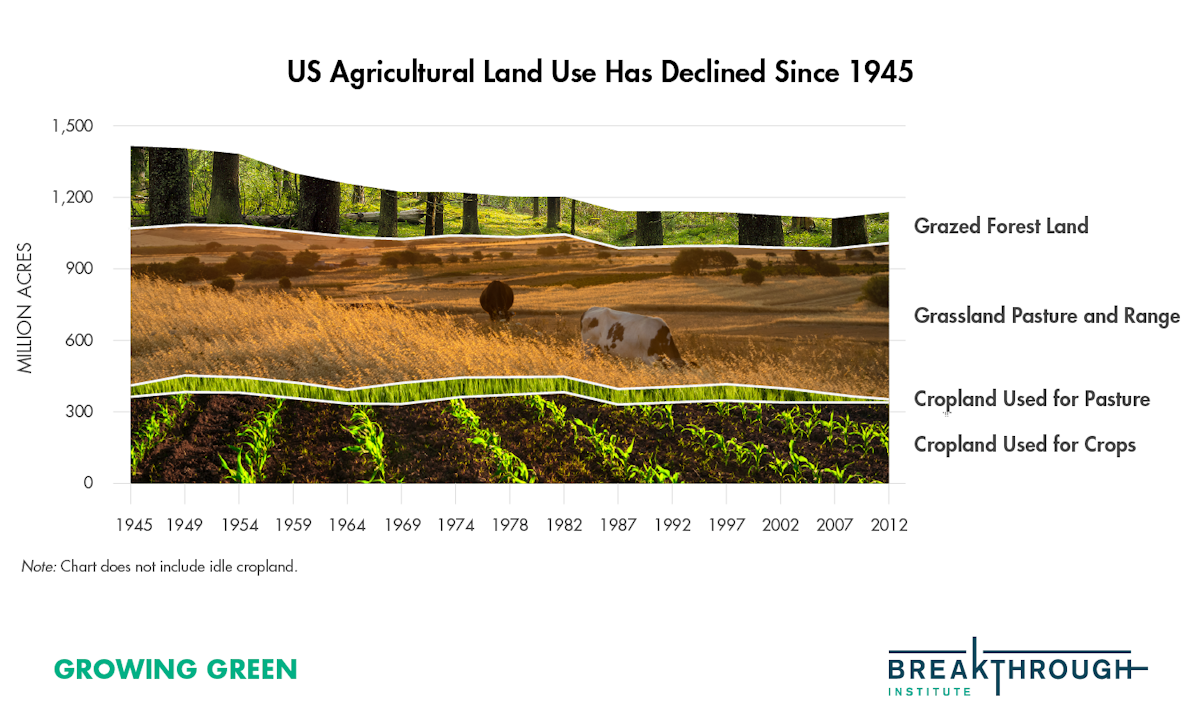
Productivity growth has also avoided even higher emissions from agriculture by reducing the emissions per unit of food produced. For example, since 1961, greenhouse gas emissions per pound of US beef declined by almost 35 percent.Data retrieved from FAOStat, accessed July 6, 2022, https://www.fao.org/faostat/en/#home. Over the same period, the emissions intensity of rice production in the United States declined by 48 percent.
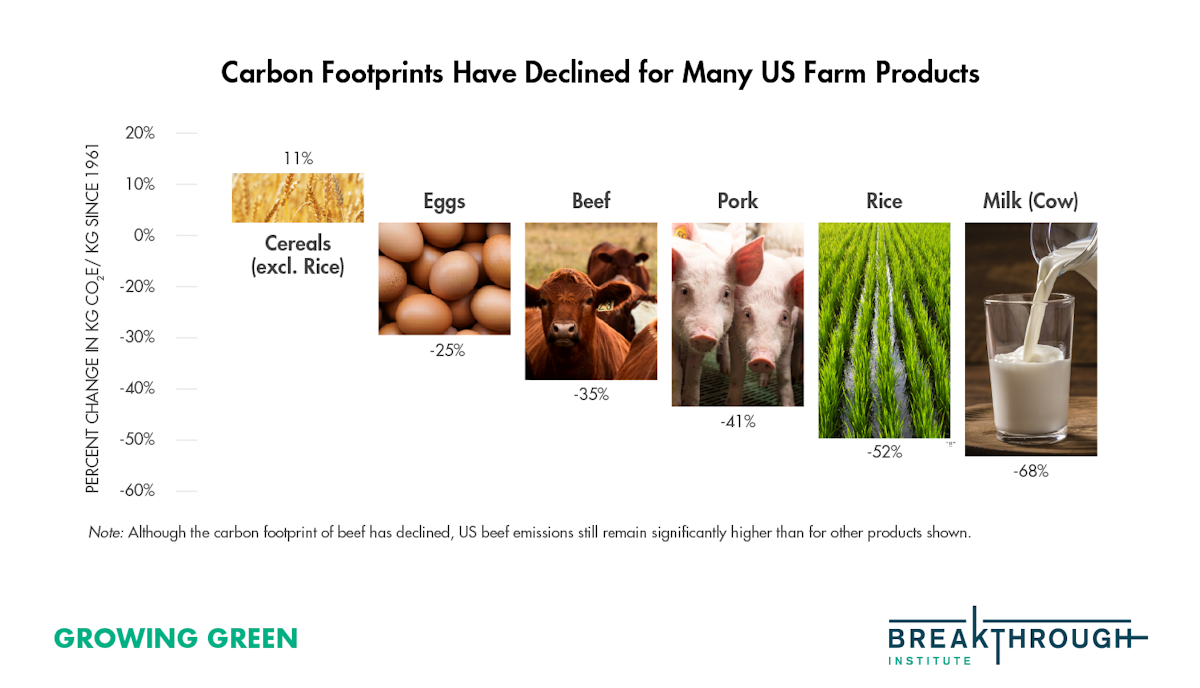
Public Agricultural R&D Drives Productivity Growth
Publicly funded agricultural R&D played an important role in the US agricultural productivity growth of the 20th century.
The main driver of productivity growth is innovation. And the best driver of innovation, according to economists at the USDA Economic Research Service as well as the broader literature on innovation, is public research spending.Wang et al., Agricultural Productivity Growth in the United States, 38.Fred Block and Matthew Keller, State of Innovation: The US Government’s Role in Technology Development (New York: Routledge, 2011).Mariana Mazzucato, The Entrepreneurial State: Debunking Public vs. Private Sector Myths (London: Anthem Press, 2013).
Public agricultural R&D works to elucidate fundamental scientific questions that allow for long-run technological breakthroughs. The public sector also conducts important applied research in areas that the private sector lacks sufficient incentive to fund, such as climate change mitigation, natural resources, and other topics that have less potential for commercial success. Similarly, public research agencies are more likely to support high-risk research that has a lower chance of generating profits in the short term, like developing crops that sequester more carbon or fix nitrogen.
In the past decades, public funding for productivity-improving agricultural research has declined, potentially limiting the long-run productivity-improving knowledge produced by scientists in the public sector.Wang et al., Agricultural Productivity Growth in the United States, 45.Nelson and Fuglie, “Investment in US Public Agricultural Research.” Instead, public sector research funding has gone to programs focused on more local environmental impacts, food safety, and food security.Pardey and Alston, “Drivers of US Agricultural Productivity Growth,” 15. These are valuable research areas in and of themselves and must be funded, but should come in addition to productivity-related research, not at its expense.
Private sector R&D spending has dramatically increased in recent decades but can’t fill the gap created by the decline in public spending since the two sectors support fundamentally different types of activities. While private R&D often builds off and takes advantage of basic scientific findings from public research, much of the funding in private sector R&D focuses on products in established market areas and efforts like manufacturing technologies that give individual companies competitive advantages.John King, Andrew Toole, and Keith Fuglie, The Complementary Roles of the Public and the Private Sectors in US Agricultural Research and Development, USDA Economic Research Service, September 2012, 4, https://www.ers.usda.gov/webdocs/publications/42858/32186_eb19.pdf?v=0.
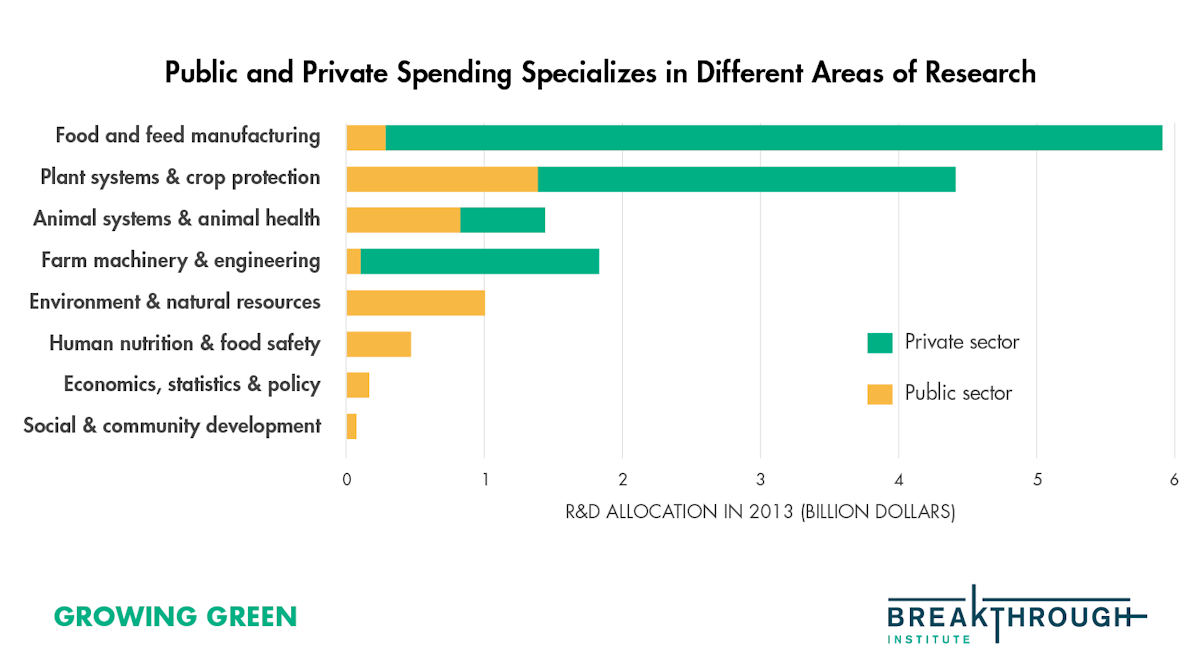
This is not to say that publicly and privately funded R&D efforts are at odds with one another, or that private R&D is not important or beneficial to productivity growth. In fact, public R&D is generally thought to complement or stimulate private research,Wang et al., Agricultural Productivity Growth in the United States, 40. putting productivity-improv-ing breakthroughs within reach for private firms that might otherwise avoid the high costs of knowledge creation. For example, USDA’s investment in chicken breeding in the middle of the 20th century, in partnership with private companies and producers, made possible significant breakthroughs in broiler chicken size and growth rate that were quickly adopted nationwide (see Case Study: The Chicken of Tomorrow).
Case Study: The Chicken of Tomorrow
In 1945, as World War II was coming to an end and a new era of mass consumption was just over the horizon, A & P Food Stores, one of the largest grocery store chains of its time, partnered with the USDA and an industry committee to sponsor a “Chicken of Tomorrow” competition aimed at breeding a chicken with more meat.H. L. Shrader, “The Chicken-of-Tomorrow Program: Its Influence on ‘Meat-Type’ Poultry Production,” Poultry Science 31, no. 1 (January 1952): 3-10, https://reader.elsevier.com/re... 013?token=66C2EEEDFD9162094C868F4F45EE70993246FABC7732B1695FAE0C103929D983AF5 2CD932409A8DA3BCF5D00783C4EDC&originRegion=us-east-1&originCreation=20220630195511.Over the following six years, state competitions were held in 42 states, and two national competitions were held in Delaware and Arkansas. The result was a heavier, faster-growing broiler chicken.
The winner of both national competitions was a hybrid between a New Hampshire and California Cornish chicken, bred by Charles Vantress of California. Until then, purebreds were preferred over hybrids due to producers’ fears of poor health in hybrids, but Vantress’s “Chicken of Tomorrow” quickly became a national standby for broiler chickens. They grew quickly and produced far more meat than the average purebred of the 1940s. The chicken industry quickly took up the Vantress Cross, and in short order, the purebred chicken was replaced by Vantress’s hybrid or some descendant of the cross.
Since the 1940s, American chicken consumption has skyrocketed, at least in part due to the “Chicken of Tomorrow.” Around the turn of the millennium, US chicken consumption outpaced beef for the first time and has since been the most consumed American meat.
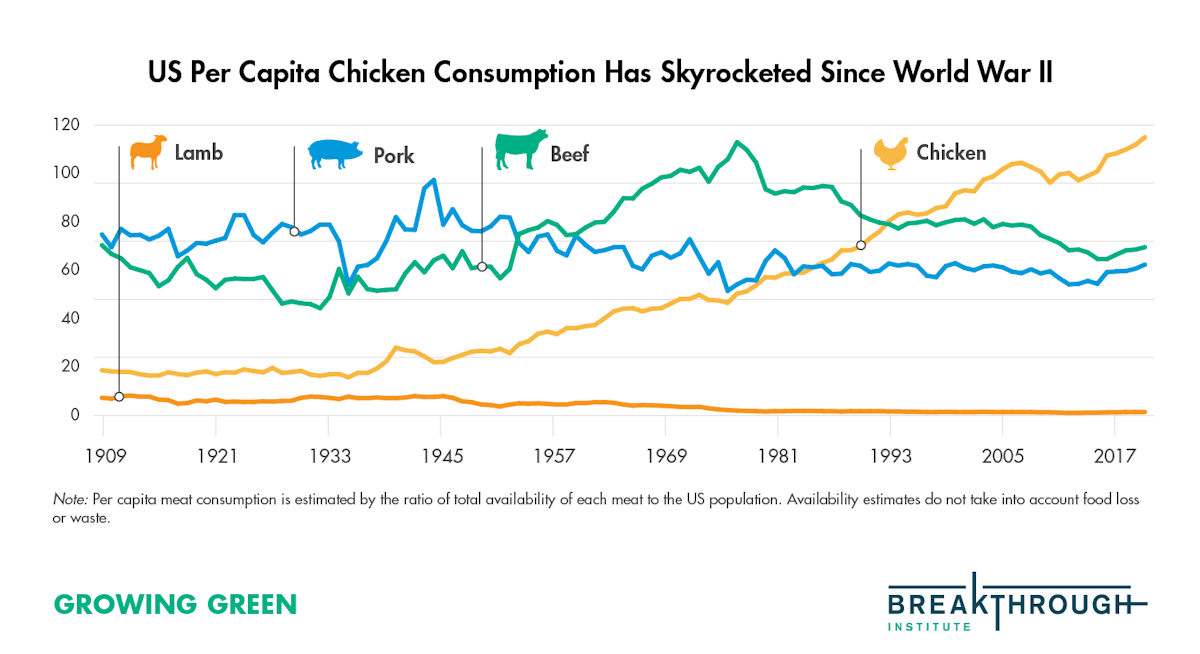
While the growth of the broiler chicken industry and the success of the Vantress Cross have created prob-lems (antibiotic resistance and Avian flu risk, for starters), they have also proven a boon for the climate. Chicken’s meteoric rise has coincided with a decline in beef consumption since the mid-1970s.James Eales and Laurian Unnevehr, “Demand for Beef and Chicken Products: Separability and Structural Change,” American Journal of Agricultural Economics 70, no. 3 (1988): 521-32. If beef or pork, instead of chicken, were responsible for the growth in US meat consumption since the middle of the 20th century, total US agricultural emissions would have been significantly higher.
Case Study: B73 Corn
In 1972, the USDA Agricultural Research Service, alongside scientists at Iowa State University, released a new maize inbred line: B73. Since then, B73 has become a pivotal corn breed for American and global agriculture, contributing to the incredible increase in maize yields over the last half-century. According to Iowa State University, B73 “remains the basis for nearly all the seed-parent lines of corn used in the United States and throughout the temperate areas of the world.”Iowa State University, “Major Cultivar Releases by the ISU College of Agriculture and Life Sciences,” 17, https://www.iastatedigitalpress.com/farmreports/article/11508/galley/10849/view/.
In the years before B73 was developed and spread, ARS and other publicly funded organizations were significant contributors to plant-breeding efforts. Numerous important breeds of corn and other crops were produced, studied, and distributed through public experiment stations and land-grant universities. But, over the past half-century, public researchers have moved away from plant-breeding, to be replaced by private sector research and development and corporatized plant-breeding efforts. While private efforts have been successful in many ways, the drop-off in public sector breeding efforts has meant less capacity for innovation from within those seed companies that have taken up the task of breeding.Thomas Hoegemeyer, “History of the US Hybrid Corn Industry,” presented at University of Nebraska-Lincoln, n.d., http://imbgl.cropsci.illinois.edu/school/2014/11_THOMAS_HOEGEMEYER.pdf.
The success of B73 and the subsequent diminishing of US public plant-breeding capacity also serve as an important lesson for forward-looking policy.Lindsay Campbell, “America’s Public Plant Breeding Programs Are in Trouble,” Modern Farmer, August 19, 2020, https://modernfarmer.com/2020/08/americas-public-plant-breeding-programs-are-in-trouble/. Even in a field dominated by private sector R&D, such as plant breeding, public sector R&D can develop breakthroughs that benefit the entire industry. Whereas private sector technological breakthroughs are often siloed and protected as intellectual property, public R&D tends to produce open-access findings that can serve as the basis for even greater private breakthroughs. The public nature of B73 maize, for instance, enabled seed companies, large and small, to create vastly improved products.
Agricultural R&D is Climate Mitigation
Agricultural production accounts for about 10 percent of US greenhouse gas emissions and 12 percent of global emissions.EPA, “Inventory of US Greenhouse Gas Emissions.”“World Greenhouse Gas Emissions: 2019,” World Resources Institute, June 23, 2022, https://www.wri. org/data/world-greenhouse-gas-emissions-2019. R&D that targets enteric fermentation (a digestive process in cattle and other ruminants that generates methane emissions), nitrous oxide emissions from fertilizer use and other activities on cropland soil, manure management, carbon sequestration, and other areas could substantially reduce net US emissions.
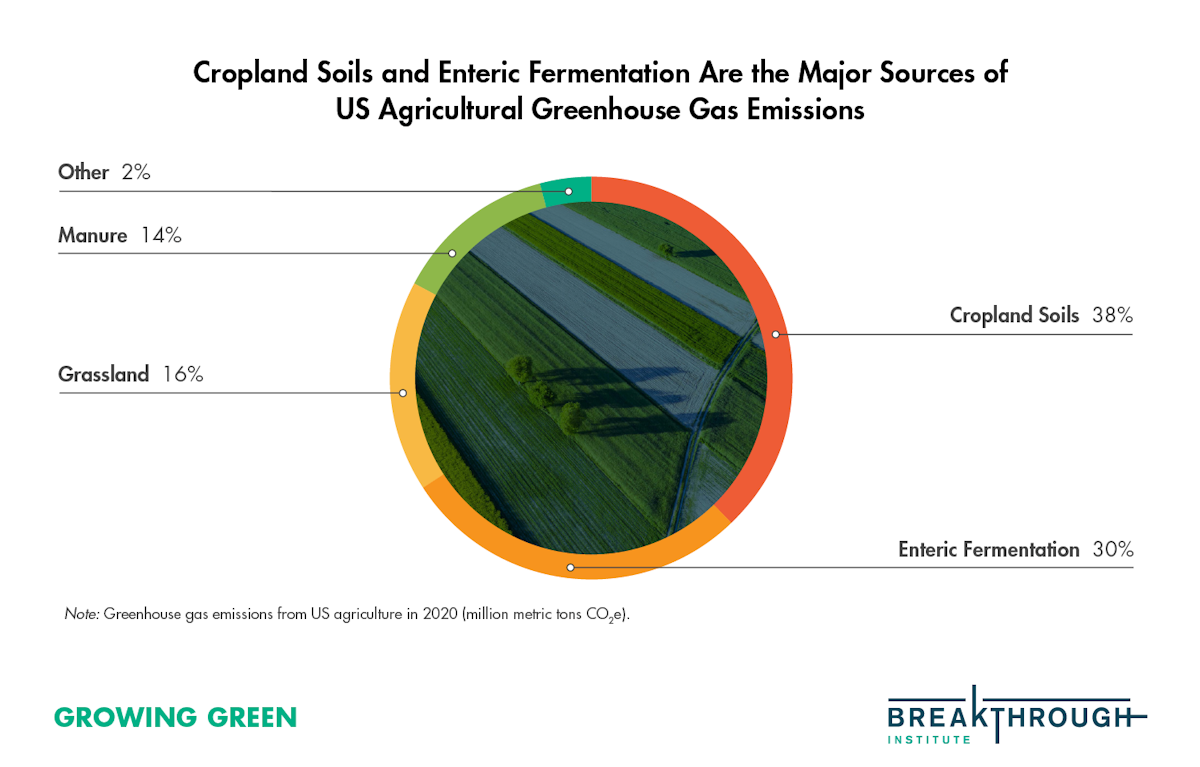
US agricultural R&D can also reduce global emissions by increasing agricultural yields and thereby reducing the conversion of forest, grasslands, and other native vegetation to farmland. A 2018 World Resources Institute report estimated that increasing global crop and livestock yields at the same rate they have historically risen would avoid more land-use change and greenhouse gas emissions by 2050 than all other plausible food system changes combined. Without any improvements in productivity, meeting projected global food demand in 2050 “would entail clearing most of the world’s remaining forests, wiping out thousands more species, and releasing enough greenhouse gas emissions to exceed the 1.5°C and 2°C warming targets enshrined in the Paris Agreement—even if emissions from all other human activities were entirely eliminated.”Tim Searchinger et al., “Creating a Sustainable Food Future: Executive Summary (Synthesis),” World Resources Institute, December 2018, https://research.wri.org/wrr-food/executive-summary-synthesis. Yet increasing agricultural yields faces new challenges.
Climate change has decreased global yields for some important crops such as maize and soybeans.Cheikh Mbow et al., IPCC Special Report on Climate Change and Land: Chapter 5, Food Security, Intergovernmental Panel on Climate Change, https://www.ipcc.ch/srccl/chap..., Section 5.2.2.1. As temperatures rise, they are expected to be increasingly detrimental to crop productivity. Similarly, global livestock yields are likely to decline given heat and drought stress on animals in extensive systems.Mbow et al., IPCC Special Report on Climate Change and Land: Chapter 5, Food Security, Section 5.2.2.2. In the United States, drought, heat stress, and other extreme weather events could reduce yields for both crops and livestock.“Climate Impacts on Agriculture and Food Supply,” Environmental Protection Agency, accessed June 12, 2022, https://climatechange.chicago.gov/climate-impacts/climate-impacts-agriculture-and-food-supply. These impacts threaten food security and risk triggering deforestation and other land-use change.
Agricultural research and development will be crucial to maintaining and increasing yields in the face of climate change, both diminishing the risk of climate-related food insecurity and reducing the overall greenhouse gas and land-use footprint of the global food system.
One recent study by economists at USDA ERS and Purdue University estimated that a $611 billion increase in worldwide publicly funded R&D during the period 2017 to 2050 would reduce greenhouse gas emissions from global agriculture by about 28 to 43 billion metric tons (Gt) carbon dioxide-equivalent (CO2e) by 2050, depending on how much R&D increases in developed vs. less developed countries.Keith Fuglie et al., “The R&D Cost of Climate Mitigation in Agriculture,” Applied Economic Perspectives and Policy, 2022, https://doi.org/10.1002/aepp.13245. When combined with environmental and conservation policies aimed at curbing land use for agriculture and imposing stricter regulations on producers, such a policy is projected to reduce global agricultural emissions by as much as 28 percent, or 85 Gt CO2e, by 2050. In both cases, a productivity-enhancing research agenda can also help keep food prices low and reduce the costs of implementing environmental policies by ensuring land rents remain cheap. In all, the cost of carbon mitigation would be about $14 to 22 per ton CO2e for the first scenario and $19 per ton CO2e for the second.Fuglie et al., “R&D Cost of Climate Mitigation,” 14, Table 3.
A new analysis commissioned by the Breakthrough Institute estimates the land use and climate impacts of increasing public agricultural R&D specifically in the United States.Uris Baldos, “Investing in Public R&D for a Competitive and Sustainable US Agriculture,” Paper presented at the Agricultural and Applied Economics Association Annual Meeting, Anaheim, CA, July 31-August 2, 2022, https://ageconsearch.umn.edu/record/322242/files/22891.pdf. Roughly doubling US public agricultural R&D spending over ten years would, by increasing productivity, reduce global emissions by an average of 213 million metric tons CO2e per year. That is equivalent to over one-third of current US agricultural emissions. This would be highly cost-effective compared to many mitigation options: about $12 per metric ton CO2e per year (USD 2017). This relatively low value highlights how, compared to R&D in many other countries, US public R&D generates large positive spillovers, sharing knowledge with other countries that boosts their productivity as well. Despite a net present cost of about $86 billion, doubling R&D would have a net positive economic impact, generating about $174 billion in net present value by increasing US farm output.
While increasing US R&D spending would reduce land-use and greenhouse gas emissions globally, it would have the opposite effect domestically. This is because as US producers reap the productivity benefits of agricultural R&D, the price of American agricultural goods would decline, making them more competitive on the global market. This would lead to increases in domestic crop outputs and subsequently an expansion in agricultural lands. But domestic increases in agricultural land use and emissions do not offset declines in global agricultural lands, emissions, and food prices.
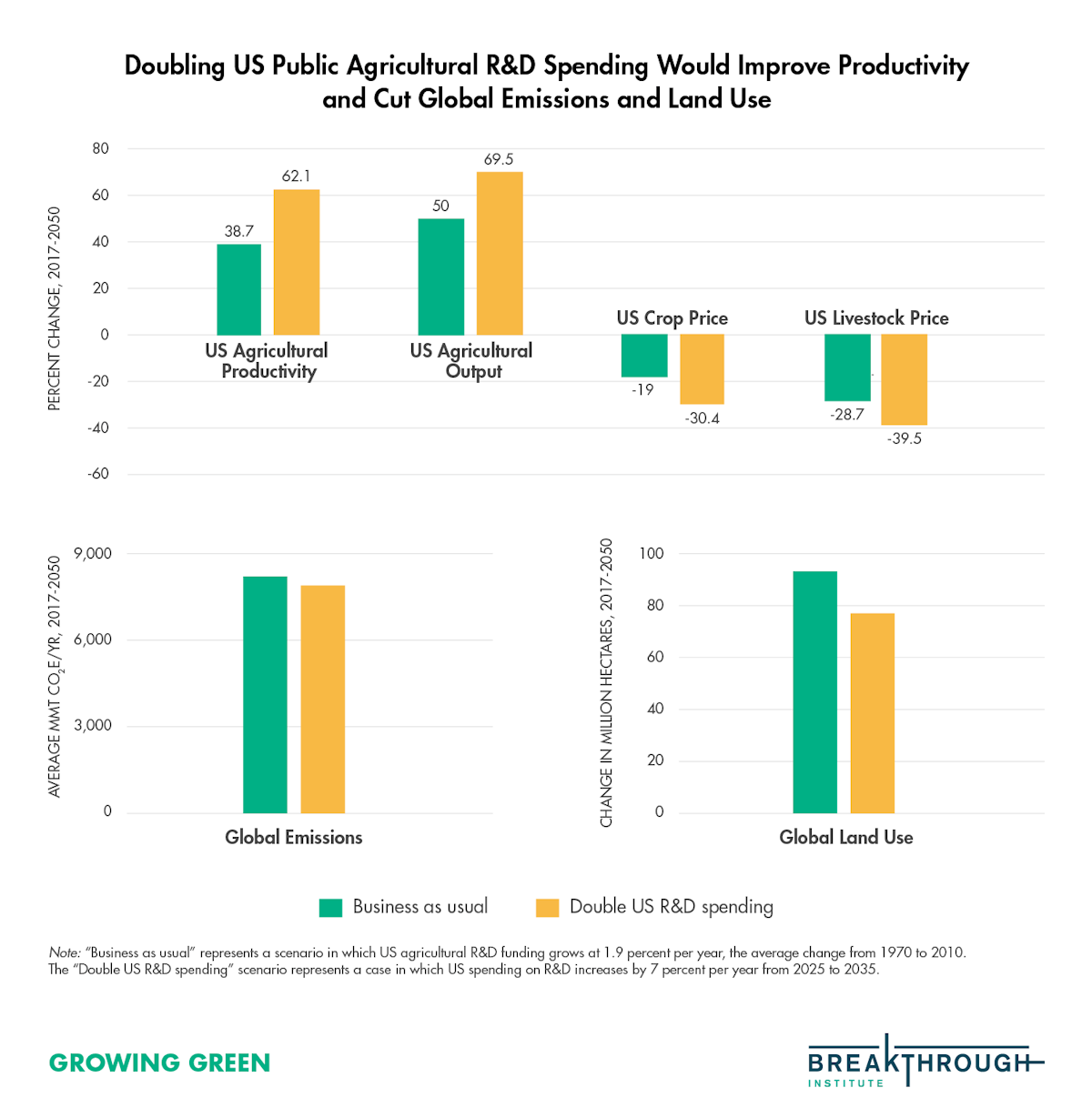
Overall, costs per ton abated from investing in agricultural R&D are significantly lower than for many other emissions mitigation strategies. Estimates for the marginal cost of abatement from agricultural R&D in developed economies consistently fall under $30 per ton CO2e abated.David B. Lobell, Uris Lantz C. Baldos, and Thomas W. Hertel, “Climate Adaptation as Mitigation: The Case of Agricultural Investments,” Environmental Research Letters 8, no. 1 (2013), https://doi. org/10.1088/1748-9326/8/1/015012.Carol Adaire Jones, Cynthia J. Nickerson, and Paul W. Heisey, “New Uses of Old Tools? Greenhouse Gas Mitigation with Agriculture Sector Policies,” Applied Economics Perspectives and Policy 35, no. 3 (2013): 423-24, https://doi.org/10.1093/aepp/ppt020. In contrast, many energy and transportation technologies such as zero-carbon synthetic fuels, direct air carbon capture, and hydrogen electrolysis have negligible or no mitigation potential at similar costs.Jamil Farbes, Ben Haley, and Ryan Jones, Marginal Abatement Cost Curves for US Net-Zero Energy Systems: A Systems Approach, Environmental Defense Fund, August 2021, 5-6, https://www.edf.org/sites/default/files/documents/MACC_2.0%20report_Evolved_EDF.pdf.
Policy Recommendations
Public agricultural R&D funding has been falling. While funding for federal agricultural R&D agencies increased in 2022 to just over $3.5 billion, total public funding for R&D—omitting funding for extension, education, and other activities that R&D agencies also engage in—is far below funding levels from the 1980s to 2000s, adjusting for inflation.Dan Blaustein-Rejto and Caroline Grunewald, “Federal Ag Innovation Funding Rose This Year, But Still Lags,” The Well News, May 13, 2022, https://www.thewellnews.com/opinions/federal-ag-innovation-funding-rose-this-year-but-still-lags/.Nelson and Fuglie, “Investment in US Public Agricultural Research.” In comparison, the Department of Energy’s budget for energy research, development, and deployment doubled from less than $4 billion in 2000 to about $8 billion in 2021.Colin Cunliff and Linh Nguyen, Energizing Innovation: Raising the Ambition for Federal Energy RD&D in Fiscal Year 2022, Information Technology and Innovation Foundation, May 2021, 11, https://www2.itif.org/2021-energy-innovation-funding.pdf?_ga=2.56385262.431943967.1649460171-1206423861.1649460171. We recommend the following actions to address the decline in public agricultural R&D funding.
Double Research Funding
Given the large environmental and economic benefits of agricultural R&D, Congress should double the funding for major agricultural R&D agencies and programs. For the USDA’s largest research agencies, ARS and NIFA, this would result in a combined increase of about $3.4 billion per year over their 2022 budgets, with additional funding needed to offset inflation.Ag and Environment tab, “FY23 R&D Appropriations Dashboard,” American Association for the Advancement of Science, April 22, 2022, https://www.aaas.org/news/fy-2023-rd-appropriations-dashboard.
Doubling funding for the ARS would bring more investment to its work on agricultural productivity, adaptation, and environmental research. The ARS performs crucial productivity-focused research through multiple projects in labs across the United States. For example, its “Animal Production and Protection” and “Crop Production and Protection” program areas fund research into productivity growth, while its “Natural Resources and Sustainable Agricultural Systems” program area carries out research with direct environmental applications.
Similarly, doubling funding for NIFA’s Agriculture and Food Research Initiative from $445 million in 2022 to about $900 million annually would allow more researchers to tackle research questions aimed at improving agricultural yields in the face of climate change. There is already a clear demand for more research funding. In 2019, AFRI’s programs were able to fund only 47 percent of the highly ranked applications that its review committees recommended for funding.“Agriculture and Food Research Initiative (AFRI) FY 2019 Annual Review,” USDA National Institute of Food and Agriculture, 2, accessed July 7, 2022, https://www.nifa.usda.gov/sites/default/files/resource/AFRI%20Annual%20Review%20v2%202019%20text%20508%20final.pdf. Because AFRI funds researchers from a range of institutions—at universities, national laboratories, private institutions, and even businesses—its support helps to maintain a broad ecosystem of agricultural research.
Expanding funding for the Foundation for Food & Agriculture Research (FFAR) would also have significant benefits. The 2018 Farm Bill provided $185 million in funding over five years.Genevieve K. Croft, “2018 Farm Bill Primer: Agricultural Research and Extension,” Congressional Research Service, September 24, 2019, https://crsreports.congress.go...,Congress%20receives%20the%20 strategic%20plan. For every dollar that FFAR spends on research, it must find matching investment from private sources, leveraging the impact of public funding. FFAR has matched every dollar of federal investment with an average $1.40 in private funds.Advancing Research, Partnership & Impact: 2021 Impact Report, Foundation for Food & Agriculture Research, 2, https://1r0ixf4416603ktoc7u7n6pe-wpengine.netdna-ssl.com/wp-content/uploads/2022/05/FFAR-2021-Impact-Report.pdf. In addition, as much as a third of FFAR’s total research investment goes toward climate change mitigation and adaptation.Personal communication, Rose Barbuto, Crystal Strategies. Internal analysis, available upon request, indicates about 25% of FFAR spending from 2017 to 2021 was on projects with a climate change mitigation component. Because of FFAR’s role as a public-private initiative, it can also help build consensus across research institutions and align research priorities to avoid redundancies in public and private research.
Increasing R&D funding for the National Science Foundation, ARPA-E, and other agencies that fund agricultural R&D would also be beneficial. However, since agricultural R&D is a small part of their overall missions and budgets, additional funding would likely impact agriculture less than if it were provided to FFAR or to USDA agencies.
Fully Establish AgARDA
Standing up the Agriculture Advanced Research and Development Authority (AgARDA) would fill a critical research niche for the development of innovative technologies. AgARDA was authorized as a pilot initiative by the 2018 Farm Bill for $50 million per year in funding,Croft, “2018 Farm Bill Primer.” but has only received $1 million to date and has yet to establish a strategic plan.Blaustein-Rejto and Grunewald, “Federal Ag Innovation Funding.” Funding the program at its authorized level would allow AgARDA to begin acting as a legitimate research agency alongside the USDA’s main programs. AgARDA can support multiyear, high-risk and high-reward projects that are too risky for private investors and do not fit well into the research model of the ARS or AFRI, which prioritize lower-risk projects that reliably deliver incremental progress, or FFAR, which requires the private sector to be sufficiently interested in a project to provide matching funding.
AgARDA takes the existing ARPA programs—such as the Department of Defense’s DARPA and Department of Energy’s ARPA-E—as inspiration and would bring the nimbleness of those research agencies to the Department of Agriculture. DARPA and ARPA-E projects typically last fewer years than those supported by other research agencies, making it possible to shift the budget toward new opportunities and away from less promising areas. This is further enabled by unprecedented independence built into the ARPA model: DARPA and ARPA-E project funding is left up to the discretion of the organization and is not restricted by higher-level interventions from the Departments of Defense or Energy. AgARDA would thus be able to react quickly to new opportunities or challenges, such as novel diseases in livestock agriculture, and fund appropriate research to manage them.
AgARDA also would have the capacity to carry high-impact innovations over the commercialization “valley of death” by funding prototyping and scale-up of these technologies. Innovations might include methane-reducing cattle feed additives or crops bred to sequester more carbon than conventional crops. ARPA-E has successfully supported technological innovations in bridging the valley of death by connecting researchers with business leaders, loan opportunities, and corporate development as part of its Scaleup program.Jeff St. John, “ARPA-E’s New Focus: Bridging the Valleys of Death for Cleantech R&D,” Canary Media, June 1, 2021, https://www.canarymedia.com/articles/clean-energy/arpa-es-new-focus-bridging-the-valley-of-death-for-clean-tech-r-d. AgARDA would be able to take the lessons of ARPA-E and DARPA and apply them directly to agricultural research and technologies.
Increase Funding for Climate Change Mitigation Priorities
Increasing federal research funding is highly beneficial, contributing to agricultural productivity growth, climate change mitigation, and other important goals. But research on some topics can have outsized effects on boosting productivity, reducing emissions, limiting land use, and otherwise improving agriculture’s environmental performance. The following is a non-exhaustive set of research areas with particularly large climate change mitigation potential.
Crop Breeding and Genetic Engineering
Increasing crop as well as livestock yields ought to remain a central tenet of public agricultural R&D. Maintaining and increasing yields in the face of rising temperatures, widespread drought, more common heat waves, shifting pest patterns, and other impacts of climate change will be one of the key challenges over the coming decades.
While conventional crop breeding remains essential, genetic engineering is a particularly promising pathway to increase productivity and decrease greenhouse gas emissions. For example, recent research by the Realizing Increased Photosynthetic Efficiency (RIPE) research project—led by the University of Illinois and funded in part by FFAR—has made remarkable progress toward increasing crop yields by improving the biological process of photosynthesis.“Our Story,” Realizing Increased Photosynthetic Efficiency, accessed June 30, 2022, https://ripe.illinois. edu/objectives/our-story.
Such improvements to photosynthetic efficiency could have large impacts on global greenhouse gas emissions and land use. If the yield increases observed in the RIPE program were achieved for major US crops such as corn, soybeans, wheat, and cotton, avoided emissions could total 221 million tons CO2e per year.Emma Kovak, “Genetically Engineered Crops Are Key to Lower Carbon Agriculture,” The Breakthrough Institute, July 20, 2021, https://thebreakthrough.org/issues/food/ge-crops-are-key-to-lower-carbon-ag.
The Agricultural Genome to Phenome Initiative could provide additional public investment in genetic engineering research. It received authorization in the 2018 Farm Bill for $40 million in funding per year, but has received only $1 million in funding to date. Reauthorizing the pro-gram in the 2023 Farm Bill and funding it to the authorized levels would support foundational research that would improve efficiency and productivity of crops as well as livestock.
Livestock Agriculture and Enteric Methane
Animal agriculture and production of animal feed are responsible for a significant portion of US agricultural greenhouse gas emissions, most of its land use, and other environmental problems such as water and air pollution.Peter H. Lehner and Nathan A. Rosenberg, Farming for Our Future: The Science, Law, and Policy of Climate-Neutral Agriculture (Washington, DC: Environmental Law Institute, 2021). Gains in livestock productivity have served to keep food prices low, reduce emissions intensities, and limit land use. But the environmental impacts of livestock production, particularly beef and dairy production, in the United States remain very high.
Though enteric methane, which is generated through cattle and other ruminants’ digestive processes, is responsible for about 28 percent of US agricultural greenhouse gas emissions, it receives little federal research funding. Less than 1 percent of funding from USDA research agencies for climate mitigation is devoted to projects focused on enteric methane.Internal analysis, Breakthrough Institute. Available upon request.
While R&D cannot eliminate the carbon or land footprint of livestock production, it can nevertheless substantially reduce its environmental impact.Dan Blaustein-Rejto, Alex Smith, and Emma Kovak, “The Clean Cow: Cutting the Carbon Footprint of US Beef Production,” The Breakthrough Institute, October 21, 2021, https://thebreakthrough.org/issues/food/the-clean-cow. For example, public R&D into feed additives can significantly inhibit enteric methane emissions from cattle. Feeding beef cattle in feedlots Asparagopsis taxiformis, a red seaweed, has been found to reduce methane emissions as much as 98 percent, though most trials find more modest results.Robert D. Kinley et al., “Mitigating the Carbon Footprint and Improving Productivity of Ruminant Livestock Agriculture Using a Red Seaweed,” Journal of Cleaner Production 259 (June 2020), https://www. sciencedirect.com/science/article/pii/S0959652620308830. Widespread use of this additive could dramatically cut dairy and beef’s carbon footprint, but only if researchers find ways to cost-effectively administer it to grazing cattle, improve cultivation of the seaweed at scale, demonstrate efficacy and safety over long-term feeding trials, and overcome other technical challenges.Blaustein-Rejto, Smith, and Kovak, “The Clean Cow.”
Other potential public R&D targets to reduce emissions include breeding more efficient livestock, conducting basic research on the cattle rumen, and addressing heat stress for confined animals and thereby improving their health and productivity.Blaustein-Rejto, Smith, and Kovak, “The Clean Cow.”“Anaerobic Digestion on Swine Farms,” Environmental Protection Agency, updated October 25, 2021, https://www.epa.gov/agstar/anaerobic-digestion-swine-farms.Günther Schauberger et al., “Global Warming Impacts on Confined Livestock in Buildings: Efficacy of Adaptation Measures to Reduce Heat Stress for Growing-Fattening Pigs,” Climatic Change 156 (2019): 567-87, https://link.springer.com/article/10.1007/s10584-019-02525-3.
Renewing and expanding FFAR’s funding through the 2023 Farm Bill and increasing funding for relevant AFRI and ARS programs could substantially advance scientific understanding of how to reduce livestock emissions, particularly enteric methane. In 2021, FFAR created the Greener Cattle Initiative, an industry consortium, to award about $5 million to R&D aimed at reducing enteric methane emissions. AFRI’s Sustainable Agriculture Systems program also granted $10 million in 2021 to Colby College to study the efficacy, safety, feasibility, and consumer perception of algae-based feed additives for US dairy cattle.Emily Bass, “What Is the Agriculture and Food Research Initiative?,” The Breakthrough Institute, June 28, 2022, https://thebreakthrough.org/issues/food-agriculture-environment/what-is-the-agriculture-and-food-research-initiative. The Agricultural Research Service also studies feed additives, breeding, and other options to reduce enteric emissions at its centers
in University Park, Pennsylvania; Madison, Wisconsin; Bushland, Texas; Beltsville, Maryland; and other locations.“Find a Research Project,” United States Department of Agriculture, 2022, https://www.ars.usda.gov/research/projects/?q=methane&type=all. These efforts should be expanded. Leading researchers from Princeton University, Cornell University, and other institutions have called for a $100 million initiative just to run multiyear tests of feed additives.Tim Searchinger et al., “Opportunities to Reduce Methane Emissions from Global Agriculture,” November 2021, https://scholar.princeton.edu/sites/default/files/methane_discussion_paper_nov_2021.pdf.
Soil Carbon Sequestration
A significant portion of interest in agricultural decarbonization in the United States over recent years has focused on soil carbon sequestration. Carbon sequestration in agricultural soils has the technical potential to offset a significant portion of greenhouse gas emissions produced by US agriculture. But there are several limitations. Not only does measuring changes in soil carbon remain an expensive, labor-intensive process, but the effect of various farming practices, such as cover crops, on soil carbon levels also depends on a wide array of factors such as soil type, precipitation, crop type, and farm management, making sequestration rates difficult to predict. In addition, soil carbon sequestration is not highly durable; changes in farming practices or land use can re-release stored carbon.Alex Smith and Dan Blaustein-Rejto, “The Limits of Soil Carbon Sequestration,” The Breakthrough Institute, March 9, 2020, https://thebreakthrough.org/issues/food/carbon-farming.
Additional R&D could help address some limitations and enable greater, more durable sequestration. A recent report from the nonprofit organization Carbon180 proposes a plan for a soil carbon “moonshot” that includes $110 million in funding for research on soil carbon dynamics over five years and $225 million in funding for the development of crops that can sequester more carbon by growing deeper roots.Cristel Zoebisch and Giana Amador, Soil Carbon Moonshot: Grounding Carbon Storage in Science, Carbon180, March 2022, https://static1.squarespace.co... 292045a84bb233211775e7/1646862413364/Carbon180-SoilCarbonMoonshot.pdf. Though at an early stage of research, widespread adoption of such crops could theoretically sequester over 700 million tons of carbon dioxide per year in US soils, an amount greater than current-day agricultural greenhouse gas emissions.Keith Paustian et al., Assessment of Potential Greenhouse Gas Mitigation from Changes to Crop Root Mass and Architecture, Final Report to ARPA-E, Booz Allen Hamilton Inc., January 29, 2016, https://www.osti.gov/servlets/purl/1339423.
Meat and Dairy Alternatives
Public R&D funding on alternative proteins, such as plant-based meats, would be a boon for the environment while creating new jobs. Plant-based meat and dairy alternatives generally have a far smaller carbon, land, and water footprint than conventional livestock products,Saloni Shah, “Are Alternative Proteins a Climate Solution?,” The Breakthrough Institute, June 1, 2022, https://thebreakthrough.org/issues/food/are-alternative-proteins-a-climate-solution. generate less air and water pollution, and do not contribute to antibiotic resistance.Raychel E. Santo et al., “Considering Plant-Based Meat Substitutes and Cell-Based Meats: A Public Health and Food Systems Perspective,” Frontiers in Sustainable Food Systems, August 31, 2020, https://www.frontiersin.org/articles/10.3389/fsufs.2020.00134/full. In addition, if the US alternative protein industry remains globally competitive and continues to grow, it could generate 50,000 to 100,000 new domestic jobs within the coming decade.Ariel Ron and Alex Smith, “American National Competitiveness and the Future of Meat,” Good Food Institute and The Breakthrough Institute, June 14, 2022, https://thebreakthrough.org/articles/american-national-competitiveness-and-the-future-of-meat. But while the United States has funded some alternative protein R&D, funding remains low and lags the support provided by the EU, Canada, and other countries such as Singapore and China.
The federal government could establish an Interagency Alternative Proteins Initiative to coordinate R&D across multiple agencies and levels of government. In addition, federal and state governments can establish and fund interdisciplinary centers of excellence focused specifically on alternative protein R&D. Research agencies should, among other priorities, focus on developing open-access databases and biomaterial repositories such as a database characterizing plant proteins, as well as support development of better ingredient processing and manufacturing equipment for alternative protein production.Ron and Smith, “American National Competitiveness and the Future of Meat.” US spending to date has been relatively paltry, about $6 million per year from 2019 to 2021, largely administered by AFRI.Data retrieved from Alternative Proteins Research Grants Tracker, accessed July 11, 2022, https://gfi. org/resource/research-grants-tracker. In 2021, the Good Food Institute proposed that the USDA direct $50 million in funding to alternative protein R&D in 2022; an investment of that size could drive down prices for alternative protein production, reduce inefficiencies, and help the industry grow to compete for markets internationally.Jessica Almy et al., Letter to the Honorable Rosa DeLauro, the Honorable Kay Granger, the Honorable Sanford Bishop, and the Honorable Jeff Fortenberry, March 2, 2021, https://gfi.org/wp-content/uploads/2021/03/FY22-Sign-On-Letter_Request-for-Alternative-Protein-Research_House_Ag_03-02.pdf.
Fertilizer Innovation
Research into enhanced efficiency and microbial fertilizers, alternative approaches to synthesizing nitrogen fertilizer, and other areas of fertilizer innovation could improve farm productivity and reduce nutrient runoff, greenhouse gas emissions, and farm input costs. However, current private sector funding for research is limited. The global fertilizer industry spends an estimated $100 million per year on R&D, 0.1 to 0.2 percent of its revenue; in contrast, the seed industry spends 10-20 percent.David R. Kanter and Timothy D. Searchinger, “A Technology-Forcing Approach to Reduce Nitrogen Pollution,” Nature Sustainability 1, no. 10 (October 2018): 547. Government incentives for private R&D or additional public funding could fill this gap. Among federal agencies, NIFA, the Department of Energy, and the National Science Foundation are particularly well suited to fund advanced fertilizer R&D as they have already provided support to the area, such as a University of Minnesota project funded by ARPA-E to use wind power for ammonia synthesis.“Wind Energy to Ammonia Synthesis,” ARPA-E, December 15, 2016, https://arpa-e.energy.gov/technologies/projects/wind-energy-ammonia-synthesis.
Acknowledgments
The Breakthrough Institute is a 501(c)(3) nonprofit environmental research center based in Berkeley, California, that identifies and promotes technological solutions to environmental and human development challenges.
Special thanks to Keith Fuglie, Uris Baldos, and Julian Alston for providing valuable information and feedback on this report. Thank you to Michael Lebwohl for originally developing the “Structure of US Public Agricultural R&D” figure. Lynn Page Whittaker performed copyediting, proofreading, and fact-checking. Layout, figure design, and cover design were done by Janet Mumford. All errors and opinions are those of the authors.

